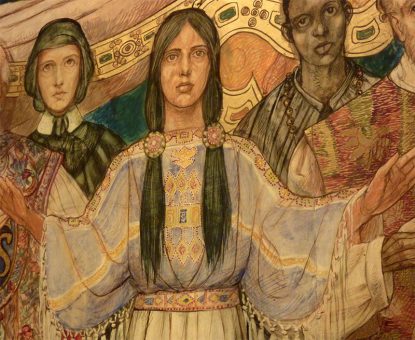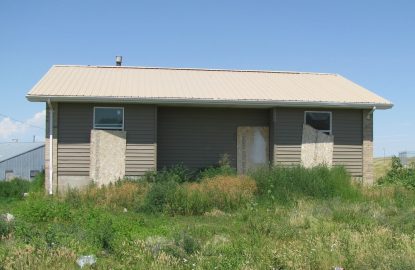
Sacred art depicts St. Kateri Tekakwitha amomg other Catholic saints. The feast day of the first Native American saint is July 14.
“We have no hope; it will always be like this.” — Lakota Sioux resident of Pine Ridge Reservation, South Dakota. ***
There are 7 million American Indians in the U.S., one-fourth living and dying on reservations under conditions rivaling third world countries. Most are Christian, many are Catholic. They are the poorest American ethnic group.
Pine Ridge is a microcosm of the worst of problems. Life expectancy is less than 44 years, 97% live below the poverty line, unemployment is over 80%. Most lack clean water and sewage, 40% lack electricity, addictions are rampant. Diseases – diabetes and cancer — are 800% higher than the national average.
The state of education is among the worst in the nation. Many schools are in need of repair with asbestos in the flooring and pipes, with lead-based paint and fire code violations. They lack basic supplies and fresh food.
The root cause of the economic situation is tied to the land, most held in trust by the federal government. They are the most regulated people on earth. Many only have the right to occupy the land. They do not own their homes and have little incentive or the money to repair them. How did it get this bad?
[hotblock]
We must go back to the “doctrine of discovery” that first appeared in Spain, later adopted by the British, and then worked its way into the U.S. Constitution and federal legislation ever since. When the “New World” was being discovered, the question was: Who is to take possession of these newly discovered lands?
Acting under the international laws of Western Christendom, Columbus was to “take possession” of the land for Spain. These “laws” took shape from two papal bulls (1452 and 1493). The intent was to recognize and defend any Spanish claim and to bring the people of the new land to Christianity at a time when Islam was spreading across Europe.
The controversial 1452 bull, Dum diversas was written before Columbus without any knowledge of a new world or the existence of any indigenous people. Popes Nicolas and Alexander I did not intend that they should be mistreated or lose their land. Pope Paul III in 1537 (in Sublimes Dues) clarified that “Indians and all other people [discovered] are by no means to be enslaved, deprived of their liberty or the possession of their property, even though they be outside the faith of Jesus Christ.” Catholic social teachings have since repeated this stance.
Over time the driving force of this “doctrine” was money, later unfolding in U.S. Indian law and Supreme Court cases under Chief Justice John Marshall (1810, 1823 and 1835).
The General Allotment Act (1887) provided the means to take millions of reservation acres guaranteed to Indians and marked the beginning of misguided paternalism by the federal government toward Indian people that continues today. The Burke Act (1906) and the Reorganization Act (1934) and amendments to the Land Consolidation Act followed. Lands not fully owned by individuals were placed into a “trust” system wherein the government has final authority over land use.

A typical house on the reservation of the Oglala Lakota Nation. (Photo by Richard May)
The fractionated patchwork of land remaining with its restrictions is a major obstacle to housing and business development. Erosion of tribal powers to govern and manage their lands and resources continues.
The legal framework today is not only inconsistent with the Constitution but also with basic human rights, having adverse consequences for the Indians and their ability to correct the social and economic injustices. Toward self-sufficiency, tribes and their governments are trying to piece together their homelands through purchases, gifts and the return of government-held land. Indian cultures and languages are at stake when the land base is diminished.
“We have no hope. It will always be like this.” No hope leads to despair, and despair leads to many social issues such as suicide and widespread substance abuse. We must restore their hope that things will improve.
The reservation poverty issue touches the core of Catholic social teachings, as we find on the battlefields of pro-life and religious freedom. Responding to this social disparity is part of our Catholic identity and requires an effective social justice advocacy. Public awareness is crucial.
While credit has to be given to organizations such as Catholic Home Missions, charitable donations are just a Band-aid on the problem. A long-term solution requires major reforms at the federal level and begins with the church’s presence on Capitol Hill, supporting the tribes and pro-Indian legislation. It must become a national priority with all Americans engaged to solve it.
Toward this end, the United States Conference of Catholic Bishops’ Subcommittee on Native American Affairs is now actively meeting with Native American leaders to listen to their concerns. The recent document “Two Rivers: A Report on Catholic Native American Culture and Ministry” provides useful data and the initial steps the church will now take.
Besides the church’s role in evangelization, it includes the need for education, and to put pressure on Congress to reform federal Indian laws governing reservations. You are encouraged to review its content.
Let us all become involved; and this begins with prayer.
***
Richard May is a writer based in the Archdiocese of Galveston-Houston.
PREVIOUS: Power of prayer revealed after sentencing of abusive ex-priest
NEXT: Freedom in the face of mandates for masks



Share this story